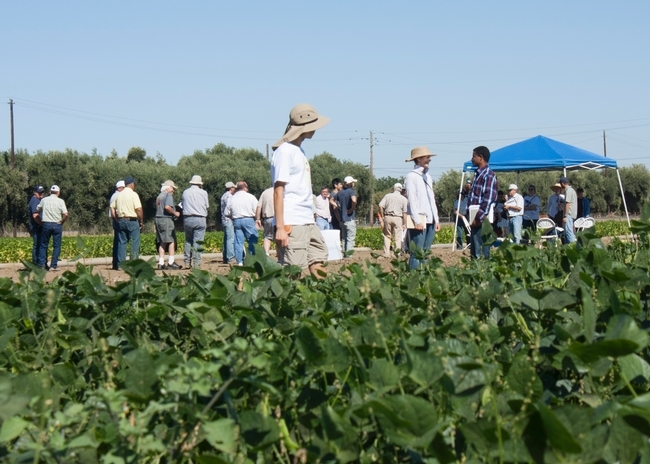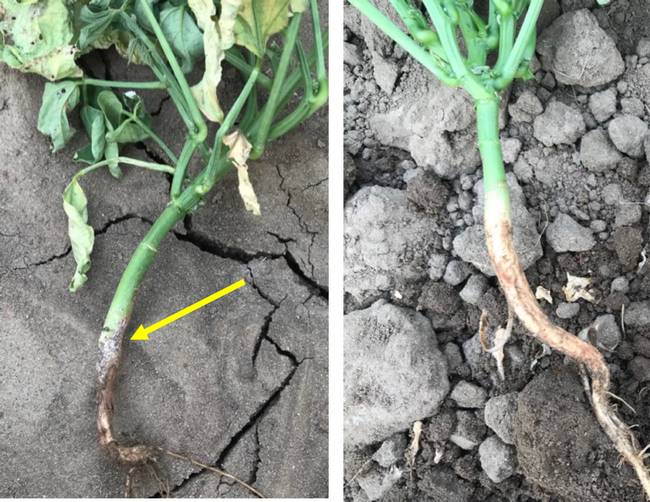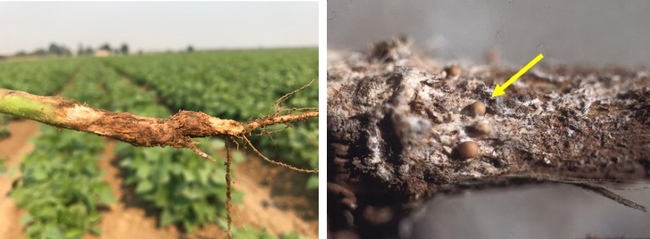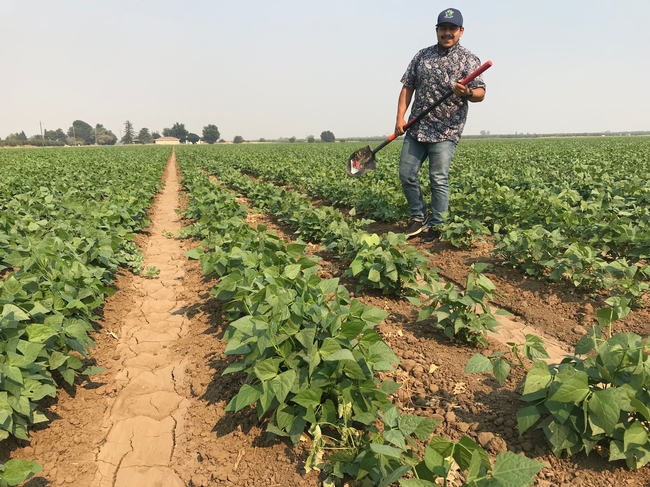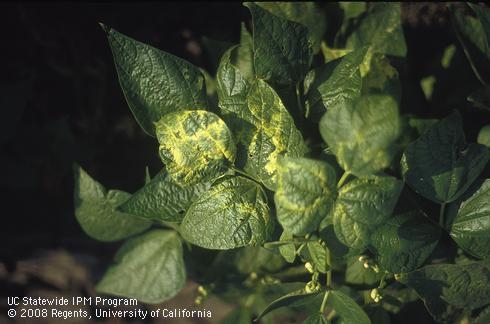- Author: Rachael Freeman Long
- Author: Sarah Light
UC Davis Agronomy Farm
Directions: In the field across from the UC Davis Bee Biology Lab (same place as previous years). From Hwy 113 in Davis, exit on Hutchison Dr. Go west, turn north at the first roundabout, then west at the second roundabout. Continue west on Hutchison Dr for about 1 mile. Turn south on Hopkins Lane (look for a row of olive trees), make your first left, and park under the trees. For questions, contact Rachael Long at 530-666-8143. No RSVP needed.
Agenda
10:00 Sign in, introductions, updates, Antonia Palkovic, UCD Assistant Specialist
10:05 UC Dry Bean Blog and IPM update, Sarah Light, Farm Advisor, Sutter-Yuba Co.
10:15 Dry bean breeding program, pest and disease resistance, Dr. Paul Gepts, UCD
10:30 Cooperative dry bean nursery, MAGIC Beans, and interspecific crosses for drought tolerance, Dr. Jorge Berny, UCD Post-doc (with Santos Barrera Lemus)
10:55 Cowpea herbicide trial, Dr. Mariano Galla, Farm Advisor Glenn Co.
11:10 Bean seed moisture and quality at harvest, Rachael Long, Farm Advisor Yolo Co.
11:20 Diallel Crossing project, Kimberly Gibson, UCD PhD student
11:35 Lima RIL trial, Stephanie Smolenski Zullo, UCD PhD student
11:50 Caravan to field location 1, near sheep barn
12:05 Heirloom breeding and Mesoamerican Diversity Panel; Drones for high throughput phenotyping, Travis Parker, UCD PhD student
12:30 Adjourn
- Author: Rachael Freeman Long
A baby lima bean field in the Sacramento Valley was recently found to be infected with southern blight (Sclerotium rolfsii), a fungal pathogen that's found in many crops. The field was double-cropped with barley and planted late June.
Symptoms and signs: Initial symptoms of southern blight include a yellowing of the foliage with a slight darkening of the stem, just above the soil line. Lesions rapidly develop, girdling the stem, causing sudden and permanent wilt of the plant. The fungus grows downward in the stem, causing rot. White mats of mycelium develop on the stem and nearby soil. In a few days, tan to brown spherical sclerotia (tiny compact masses of hardened fungal mycelium) may appear on the fungal mat. If present, these are a good diagnostic feature of this disease.
Comments on the disease: Southern blight is usually a minor disease of beans and other crops in California. However, high temperatures above 85°F together with high moisture favor the disease. High summertime temperatures combined with a later planting date likely stressed the young lima plants in this field, making them more susceptible to this disease. The best time to plant baby limas in the Sacramento Valley is around the third week in May; for large limas it's early May. Last year was a big year for southern blight in many crops, likely due to late plantings and high heat stressing the plants. This year the disease seems to be a little less common, but is still widely detected on many crops, from Kern to Sutter counties. Detections in the northern counties of the central valley have become more frequent in the last three weeks.
Disease Management: The fungus attacks a wide range of plants and survives for a long time in the soil as sclerotia. Rotations are not considered effective since this pathogen has over 500 hosts. However, it is thought that rotations to corn or small grains for at least 2 years may reduce inoculum; studies are underway to determine whether these rotations are effective. For most crops, southern blight resistant cultivars are not available. However, for vegetable crops such as tomatoes, there are some rootstocks reported to be resistant to southern blight, which are currently under study in field trials in California. Discing and burying plant refuse helps destroy sclerotia.
- Author: Michelle Leinfelder-Miles
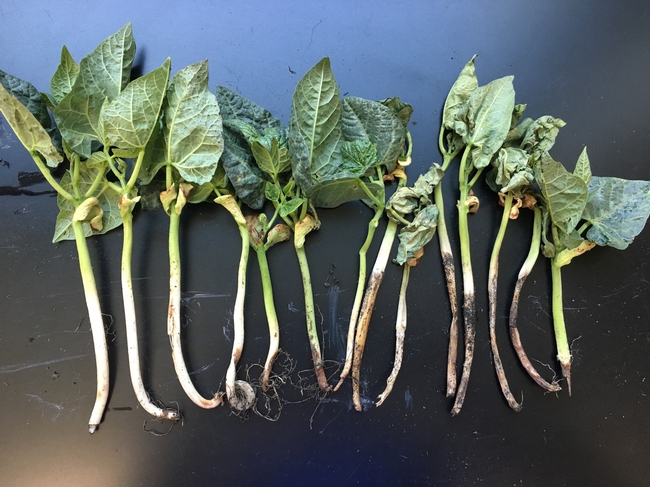
I sent plant samples to the UC Davis Plant Pathology Diagnostics lab for confirmation on disease. Rather than Rhizoctonia, the lab identified Fusarium oxysporum on all of the plant tissue submitted. While Fusarium oxysporum is the causal agent of Fusarium wilt (a.k.a. Fusarium yellows), the symptoms on these plants indicated root and crown rot, and NOT yellows. Fusarium root rot is common on other beans; however, it has not been a common problem in California limas. For this particular field, its cropping history has been various vegetables for the last couple years, including tomatoes with a severe Fusarium problem in 2016. Rotating out of beans or vegetables to grains would be a good management strategy for future years because Fusarium can live in the soil for several years. Fungicide seed treatments may also help. In this particular case, we talked about managing water well to try to avoid moisture stress (too much or too little) of the current crop to optimize the crop that is there. The grower and PCA assured me that they can manage the moisture well with the drip irrigation on this soil type. For future bean planting, waiting until soil temperature is warmer and not planting as deep would also be important strategies.
- Author: Sarah Light
A field in Sutter County was confirmed to have charcoal rot, also known as dry root rot or ashy stem blight, which is caused by the fungus Macrophomina phaseolina. The disease generally occurs under dry soil conditions paired with high temperatures and can be especially problematic when irrigation is delayed during periods of drought stress. This pathogen infects the crown and stem of garbanzo plants near the soil line and produces black cankers, which are sunken with distinct margins and often contain concentric rings. The disease is usually scattered in the field and often occurs during the flowering and pod stages (although infection can occur at all growth stages). The pathogen infects the stems of seedlings at the base of the developing cotyledon near the soil line. In older plants, symptoms include stunting, leaf chlorosis, early defoliation, and ultimately plant death. A sudden drying of whole plants scattered in the field is observed. Additionally, a “charcoal dust” can appear near the soil line on the surface of roots and stems of older plants. Canker development may kill the plant's growing tip and weaken the stem, causing stems to break, separating roots from the rest of the plant when plants are removed from the field. Infection can move into the hypocotyl and root region, as well as primary leaf petioles. The plant taproot often becomes dark, necrotic, and devoid of lateral and fine roots.
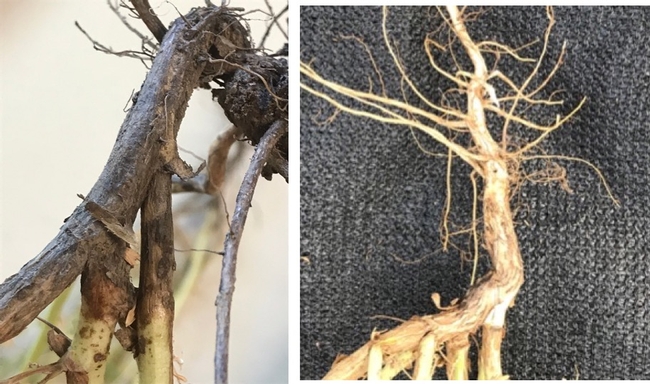
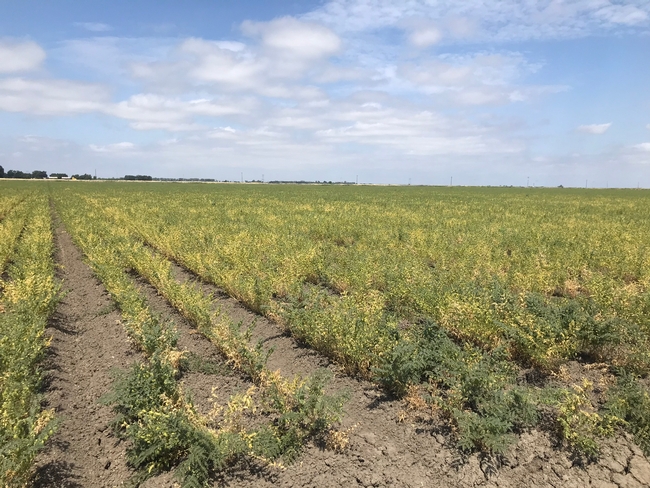
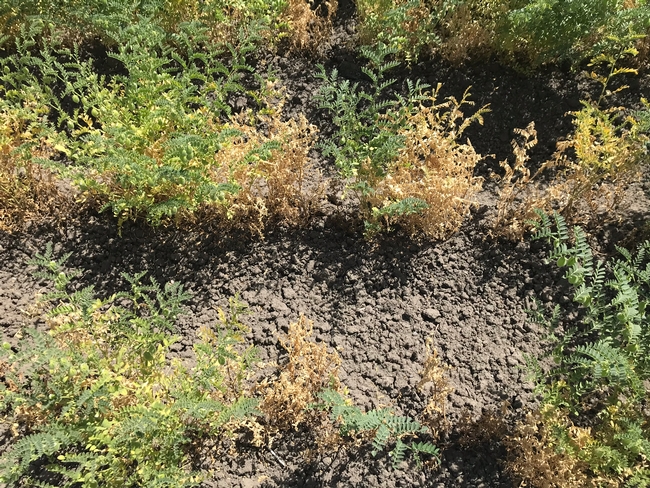
Management options in California are limited. This disease affects other legumes like common beans, blackeyes, and limas, as well as other crops that may be grown in rotation (like sunflowers). Inoculum survives in both seeds and soil. A 3-year rotation with a cereal grain (except corn and sorghum, which are hosts) is recommended to reduce soil inoculum levels. The dry, warm weather in the winter months earlier this year were conducive to drought stress for garbanzos, which increased the risk of disease. If possible, irrigate to avoid drought stress conditions. Garbanzos grown in soils that are high in organic matter tend to have more problems with this disease, however, garbanzos in other soil conditions are at risk if the plants are stressed and the environment is conducive to disease development.
- Author: Rachael Freeman Long
The Diseases and Abiotic Disorders section of the UC IPM Pest Management Guidelines for Dry Beans have been recently revised and updated and are now available online at UC IPM Dry Beans Pest Management Guidelines.
Authors include Farm Advisors Carol Frate (emeritus) and Rachael Long and UC Davis Professor Paul Gepts. Two new diseases were added, including pythium in established plants and chocolate blotch on limas. The Fusarium wilt sections were also consolidated and new photos were added throughout the guidelines. This includes an updated photo page to compare common diseases and abiotic symptoms to help identify them (Photo Identification).
With the upcoming planting season for dry beans, these guidelines can help with managing diseases in your fields. Worried about southern blight? Yes, beans are susceptible and you'll need to rotate to a non-host crop, including corn or grains for at least 2-years to reduce the inoculum. How about alfalfa mosaic virus? This disease is transmitted by aphids from alfalfa fields, so avoid planting beans adjacent to alfalfa. This information and much more are available through the revised UC IPM Dry Bean guidelines!
The remaining pest management sections, including insect pest and weed management, are in the process of being revised and will be published soon!

